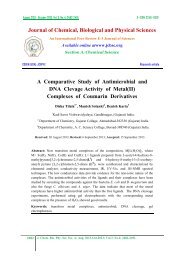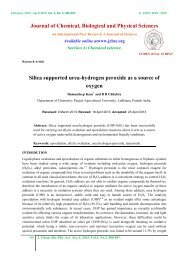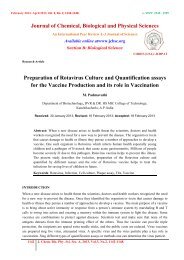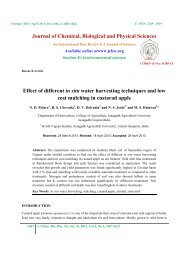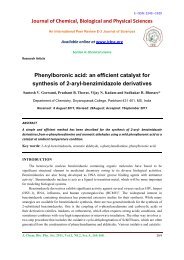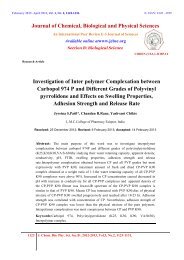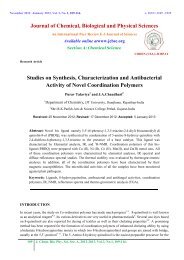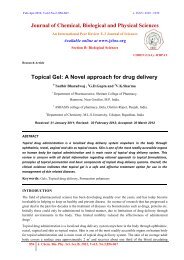<str<strong>on</strong>g>Studies</str<strong>on</strong>g> <strong>on</strong>….Suvro Saha et.al.were observed respectively for the methanol and cold water extract <strong>of</strong> nutmeg shell but the other twoextracts were not found to be effective against the organism.In Fig.6 Effect <strong>of</strong> extracts <strong>on</strong> Lactococcus lactis; am<strong>on</strong>g the four extracts <strong>of</strong> orange peel, the z<strong>on</strong>e <strong>of</strong>inhibiti<strong>on</strong> was observed for hot and cold water extract (28.70mm and 54.86mm respectively); themaximum z<strong>on</strong>e was given by cold water extracts <strong>of</strong> the orange peel. Except the acet<strong>on</strong>e extract <strong>of</strong> thest<strong>on</strong>e apple shell, the inhibiti<strong>on</strong> z<strong>on</strong>e was observed as 43.18mm, 37.08mm, 47.24mm respectively forthe methanol, hot and cold water extract <strong>of</strong> the sample. The inhibiti<strong>on</strong> z<strong>on</strong>e for the methanol extract <strong>of</strong>st<strong>on</strong>e apple was same against K. pneum<strong>on</strong>ia and L. lactis. Am<strong>on</strong>g the four extracts <strong>of</strong> pea peel andcoc<strong>on</strong>ut shell, the inhibiti<strong>on</strong> z<strong>on</strong>e (30.48mm and 33.78mm) was <strong>on</strong>ly seen for methanol extract <strong>of</strong>these two samples. The inhibiti<strong>on</strong> z<strong>on</strong>e (18.54mm) was observed <strong>on</strong>ly for the cold water extract <strong>of</strong>jackfruit peel sample. 29.46mm and 34.54mm inhibiti<strong>on</strong> z<strong>on</strong>es are observed respectively for hot andcold water extracts <strong>of</strong> banana inflorescence peel but no z<strong>on</strong>e <strong>of</strong> inhibiti<strong>on</strong> was seen for other twoextracts <strong>of</strong> this sample. Am<strong>on</strong>g the four extracts <strong>of</strong> the pumpkin peel, the z<strong>on</strong>es <strong>of</strong> inhibiti<strong>on</strong> weredetected for two extracts i.e. methanol extract (35.56mm) and hot water extract (45.72mm). No z<strong>on</strong>e<strong>of</strong> inhibiti<strong>on</strong> was produced by the four extracts <strong>of</strong> the watermel<strong>on</strong> peel. The inhibiti<strong>on</strong> z<strong>on</strong>e by the hotwater extracts <strong>of</strong> black cardamom peel and methanol extract <strong>of</strong> nutmeg shell were observed as34.54mm and 27.94mm respectively but inhibiti<strong>on</strong> z<strong>on</strong>e was not observed for the remaining extracts<strong>of</strong> these samples.Fig.7: Effect <strong>of</strong> extracts <strong>on</strong> Aspergillus niger; the z<strong>on</strong>e <strong>of</strong> inhibiti<strong>on</strong> <strong>of</strong> 41.40mm, 23.62mm,21.84mm, 31.24mm, 49.02mm, 29.46mm, 30.48mm, 81.28mm (to note that highest z<strong>on</strong>e <strong>of</strong> inhibiti<strong>on</strong>was observed against Aspergillus niger), 39.62mm were observed respectively for methanol andacet<strong>on</strong>e extract <strong>of</strong> orange, methanol and acet<strong>on</strong>e extract <strong>of</strong> st<strong>on</strong>e apple, acet<strong>on</strong>e and hot water extract<strong>of</strong> pea peel, hot water extract <strong>of</strong> coc<strong>on</strong>ut shell, cold water extracts <strong>of</strong> jackfruit peel and methanolextract <strong>of</strong> pumpkin peel.In Fig.8 Effect <strong>of</strong> extracts <strong>on</strong> Candida albicans; am<strong>on</strong>g the four extracts <strong>of</strong> the orange peel and st<strong>on</strong>eapple shell, the z<strong>on</strong>e <strong>of</strong> inhibiti<strong>on</strong> were detected as 50.8mm, 54.86mm, 22.86mm, 55.88mm, 37.08mmrespectively for the methanol extract <strong>of</strong> the orange peel, acet<strong>on</strong>e extract <strong>of</strong> st<strong>on</strong>e apple shell and peapeel, cold water extract <strong>of</strong> jackfruit peel and banana inflorescence peel and area <strong>of</strong> inhibiti<strong>on</strong> was notobserved for other extracts <strong>of</strong> these five samples. The inhibiti<strong>on</strong> z<strong>on</strong>e <strong>of</strong> 22.86mm and 41.40mm wasdetected respectively for methanol and acet<strong>on</strong>e extracts <strong>of</strong> coc<strong>on</strong>ut shell but remaining two extractswere not effective against C.albicans. No z<strong>on</strong>e <strong>of</strong> inhibiti<strong>on</strong> was observed for the pumpkin peelextracts against C. albicans. The inhibiti<strong>on</strong> z<strong>on</strong>e <strong>of</strong> 74.42mm and 35.56mm was detected respectivelyfor acet<strong>on</strong>e and hot water extracts <strong>of</strong> watermel<strong>on</strong> peel but remaining two extracts were not effectiveagainst the organism. Except for the acet<strong>on</strong>e extract <strong>of</strong> black cardamom, the remaining three extractsi.e. methanol extract (45.72mm), hot and cold water extract (46.48mm and 40.64mm respectively)were effective. Z<strong>on</strong>e <strong>of</strong> inhibiti<strong>on</strong> <strong>of</strong> 48.26mm, 68.58mm, 25.4mm were observed respectively formethanol, acet<strong>on</strong>e and hot water extracts <strong>of</strong> nutmeg shell. The highest z<strong>on</strong>e was given by acet<strong>on</strong>eextract <strong>of</strong> watermel<strong>on</strong> peel.Fig.9 Effect <strong>of</strong> extracts <strong>on</strong> Sporotrichum pruinosum, the z<strong>on</strong>e <strong>of</strong> inhibiti<strong>on</strong> <strong>of</strong> 34.54mm, 66.04mm and56.64mm were observed respectively for the methanol, acet<strong>on</strong>e and hot water extract <strong>of</strong> orange peelbut cold water extract was not observed against the organism. The z<strong>on</strong>e <strong>of</strong> inhibiti<strong>on</strong> <strong>of</strong> 36.32mm,33.02mm and 66.04mm were observed respectively for the methanol, hot and cold water extract <strong>of</strong>st<strong>on</strong>e apple shell but acet<strong>on</strong>e extract was not found effective against the organism. The z<strong>on</strong>e <strong>of</strong>inhibiti<strong>on</strong> <strong>of</strong> 39.62mm and 34.54mm were observed respectively for the hot and cold water extract <strong>of</strong>pea peel and no z<strong>on</strong>e <strong>of</strong> inhibiti<strong>on</strong> was observed for remaining two extract. Apart from methanolextract <strong>of</strong> coc<strong>on</strong>ut shell, the area <strong>of</strong> inhibiti<strong>on</strong> was observed respectively by acet<strong>on</strong>e extracts1897 J. Chem. Bio. Phy. Sci. Sec. B; 2013, Vol.3, No.3; 1886-1899.
<str<strong>on</strong>g>Studies</str<strong>on</strong>g> <strong>on</strong>….Suvro Saha et.al.(43.94mm), hot water extract (38.86mm) and cold water extract (33.78mm). In case <strong>of</strong> jackfruit peel,the z<strong>on</strong>e <strong>of</strong> inhibiti<strong>on</strong> was observed <strong>on</strong>ly for two extracts i.e. methanol extract (26.16mm) and coldwater extract (42.16mm). All the four extracts <strong>of</strong> banana inflorescence peel were not capable to inhibitthe growth <strong>of</strong> S. pruinosum. 54.86mm and 43.94mm z<strong>on</strong>e <strong>of</strong> inhibiti<strong>on</strong> was observed respectively formethanol extract <strong>of</strong> pumpkin peel and acet<strong>on</strong>e extract <strong>of</strong> watermel<strong>on</strong> peel but no z<strong>on</strong>e <strong>of</strong> inhibiti<strong>on</strong> forremaining extracts <strong>of</strong> these two samples. The z<strong>on</strong>e <strong>of</strong> inhibiti<strong>on</strong> <strong>of</strong> 49.78mm and 34.54mm weredetected for acet<strong>on</strong>e and hot water extracts <strong>of</strong> black cardamom. Except the hot water extract <strong>of</strong>nutmeg shell, the z<strong>on</strong>e <strong>of</strong> inhibiti<strong>on</strong> was detected for methanol extract (40.64mm), acet<strong>on</strong>e extract(38.1mm), and cold water extracts (38.86mm). The highest z<strong>on</strong>e <strong>of</strong> inhibiti<strong>on</strong> was observed for bothacet<strong>on</strong>e extract <strong>of</strong> orange peel and cold water extract <strong>of</strong> st<strong>on</strong>e apple shell. From the aboveobservati<strong>on</strong>s <strong>of</strong> the results, it is therefore evident that the peels, shells <strong>of</strong> vegetable, fruits, spice andshells have caused significant levels <strong>of</strong> antimicrobial effects <strong>on</strong> selected bacteria and fungi.CONCLUSIONSThe experimental findings indicate that the peel extracts comprise imperative antibacterial andantifungal properties. Am<strong>on</strong>gst the samples analyzed, the highest antibacterial and antifungal activitywas found with cold water extract <strong>of</strong> jackfruit peel against Proteus vulgaris and Aspergillus niger, andalso; methanol extract <strong>of</strong> black cardamom peel against Proteus vulgaris, methanol extract <strong>of</strong> st<strong>on</strong>eapple or bael shell against E.coli., acet<strong>on</strong>e extract <strong>of</strong> watermel<strong>on</strong> peel against C. albicans, acet<strong>on</strong>eextract <strong>of</strong> nutmeg shell against C. albicans. Thus new aspects c<strong>on</strong>cerning the use <strong>of</strong> the wastestherapeutically are precisely interesting and attractive, as menti<strong>on</strong>ed earlier, the present investigati<strong>on</strong>focuses <strong>on</strong> the possibility <strong>of</strong> using the peels and shells waste as a source <strong>of</strong> low-cost naturalantimicrobials. Except for the orange peel, antimicrobial activities <strong>of</strong> the other samples are thought tobe reported in a new perspective, thus opening up new fr<strong>on</strong>tiers for drug explorati<strong>on</strong>. Further studiesare required to determine the nature <strong>of</strong> compounds resp<strong>on</strong>sible for the antimicrobial effects from theseextracts. The chances are elevated, that the study may lead to the formulati<strong>on</strong> <strong>of</strong> an antimicrobial drugafter appropriate pharmacological evaluati<strong>on</strong> and clinical trials. The above work <strong>on</strong> peels and shells,explore new therapeutic applicati<strong>on</strong>s and also introduce an alternative method for agro-wastemanagement.REFERENCES1. Cosa P, Vlietink AJ, Berghe DV, Maes L. J Ethnopharmacol. 2006; 106: 290-302.2. Chopra I, Hodgs<strong>on</strong> J, Metcaif B, Poste G. JAMA. 1996; 275: 401-403.3. Europe to boost development <strong>of</strong> new antimicrobial drugs. The Lancet, 2012, 16,379, 2229 -2230,4. Boucher HW, Talbot GH, Bradley JS, et al. Bad Bugs, No Drugs: no ESKAPE! an updatefrom the Infectious Diseases Society <strong>of</strong> America. Clin. Infect Dis 2009; 48:1–12.5. European Centre for Disease Preventi<strong>on</strong> and C<strong>on</strong>trol/European Medicines Agency JointTechnical Report. The bacterial challenge: time to react. EMEA-576176-2009.pdf. UpdatedSeptember 2009.6. David N. Gilbert, et al. The 10 ‘20 Initiative: Pursuing a Global Commitment to Develop 10New Antibacterial Drugs by 2020. Clin Infect Dis. 2010, 50 (8):1081-1083.7. Clark, A. M. 1996. Pharm. Res. 13:1996.8. Robbers, J., M. Speedie, and V. Tyler. Pharmacognosy and pharmaco biotechnology.Williams and Wilkins, Baltimore1, 996,. 1–14.9. Marjorie Murphy Cowan..Plant Products as <strong>Antimicrobial</strong> Agents. Clinical MicrobiologyReviews, 1999, 12(4): 564–5821898 J. Chem. Bio. Phy. Sci. Sec. B; 2013, Vol.3, No.3; 1886-1899.



